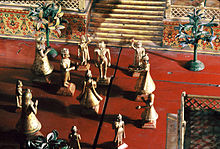Jain festivals
| Part of a series on |
| Jainism |
|---|
 |
Jain festivals occur on designated days of the year. Jain festivals are either related to life events of Tirthankara or they are performed with intention of purification of soul.
Festivals
There are many religious festivals in Jainism. Some of them are associated with five auspicious life events of Tirthankara known as Panch Kalyanaka.[1] Jains celebrate many annual festivals. Many of the major festivals in Jainism fall in and around the chaomasa (Sanskrit: chaturmasa) period of the calendar.[2] It is the four-month monsoon period when the Jain ascetics are mandated to remain in residence at one place in the Jain tradition, rather than be traveling or going around Indian villages and towns and never staying in one place for more than a month. The comasu period allows the four orders of the Jain community to be together and participate in the festive remembrances.[citation needed]
Paryushana

Janma kalayanak

Ashtahnika Parv
This is a Jain festival celebrated for eight days three times a year in the months of Kartik, Falgun and Ashdah. It is celebrated from eighth day of Shukla Paksh (Waxing moon Cycle) till Purnima/Guru Purnima every year.
Nandishwar Ashtahnika
The Nandishwara island is surrounded by three mountain ranges called the Anjana mountain, the Dadhimukha mountain, and the Ratikara mountain. Since human beings are unable to go to Nandishwar dweep they worship in temples. Jains Perform Special Pooja, SiddhChakra Vidhan, Nandishwar Vidhan and Mandal Vidhan.
The word Ashta meaning eight and Aanika meaning every day. When the festival falls in the months of Aashad and Phalguna, then the ritual is known as Nandishwar Ashtahnika. This ritual helps to gain greater spiritual insight, and wisdom. The observance of this ritual brings wish fulfilment for the devotees.
Diwali
Diwali is one of the most important festival in
New Year
After celebrating Diwali at the end of Ashwina, Jains celebrate new year on the first day of the following month of
Gyana Panchami
The fifth day of Kartika is known as Gyana Panchami. It is considered knowledge day. On this day holy scriptures are displayed and worshipped. On this day, people sometimes bow down to books and pencils
Pausha Dashmi
It is celebrated on 10th day of dark half of Pausha (Pushya) month of

Maun agiyaras
Maun Agiyaras or Ekadashi marks
The nine-day Oli is a period of semi-fasting. During these period Jains take only one meal a day of food without ghee etc., oils, or any kind of spices. It comes twice a year during March/April and September/October.
Mahamastakabhisheka
Mahamastakabhisheka is a festival held once every twelve years in the town of Shravanabelagola, Karnataka. It is held in veneration of an immense 18 meter high statue of Bahubali. The last anointing took place in February 2018, and the next ceremony will occur in 2030.[5]
Roth Teej
Roth Teej is celebrated on Bhadrapada Shukla Tritiya. On Roth Teej, the Jains are supposed to eat only one type of grain food, roth, once during the day. The festival is a reminder that material wealth is not important, only relinquishment leads to true happiness.
Varshi Tapa or Akshay Tritiya Tapa

Akshaya Tritiya is celebrated to commemorate Lord Adinath's ending of one-year fast by consuming sugarcane juice poured into his cupped hands. The first Jain
Shrut Panchami
Shrut Panchami is celebrated by Jains every year in the month of May commemorating Acharya Pushpadanta and Bhutabali.[6]
Posh Dashmi
Posh Dashmi is the festival to celebrate the life of Parshvanatha.[7]
See also
References
Citations
- ^ a b c Shah 1998, pp. 203–205
- ^ Cort 2001a, pp. 146–147.
- ^ Shah 1998, pp. 209–210
- ISBN 9781598842067.
- ^ Correspondent, TNN (8 February 2006). "Mahamastakabhisheka of Bahubali begins today". The Times of India. Archived from the original on 26 January 2013. Retrieved 19 December 2012.
- ^ Dundas 2002, p. 65.
- ^ Holt 2019, p. 260.
Sources
- Cort, John E. (2001a), Jains in the World : Religious Values and Ideology in India, Oxford University Press, ISBN 978-0-19-513234-2
- ISBN 0-415-26606-8
- Shah, Natubhai (1998), Jainism: The World of Conquerors, vol. 1, Sussex Academic Press, pp. 169–218, ISBN 9781898723301
- Jaini, Padmanabh S. (1998), The Jaina Path of Purification, Motilal Banarsidass, pp. 188–240, ISBN 9788120815780
- ISBN 9781908258984
